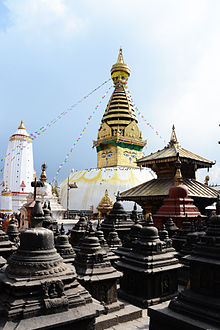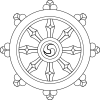Swayambhunath, The World Heritage Sites Of Nepal
 | |
| Information | |
|---|---|
| Location | |
| Address | Swayambhu, Kathmandu |
| Country | Nepal |
| Part of a series on |
| Buddhism |
|---|
 |
| Part of a series on |
| Tibetan Buddhism |
|---|
 |
swayambhunath is an historical non secular architecture atop a hill inside the kathmandu valley, west of kathmandu metropolis. the tibetan call for the web site way 'chic timber' (wylie:phags.pa shing.kun), for the numerous styles of bushes discovered on the hill. however, shing.kun can be a corruption of the neighborhood nepal bhasa name for the complicated, singgu, meaning 'self-sprung'. for the buddhist newars in whose mythological records and origin fable in addition to every day non secular exercise, swayambhunath occupies a primary role, it might be the most sacred among buddhist pilgrimage web sites. for tibetans and fans of tibetan buddhism, it is 2nd handiest to boudhanath.
The Swayambhunath complex consists of a stupa, a variety of shrines and temples, some dating back to the Licchavi period. A Tibetan monastery, museum and library are more recent additions. The stupa has Buddha's eyes and eyebrows painted on. Between them, the number one (in Devanagari script) is painted in the fashion of a nose. There are also shops, restaurants and hostels. The site has two access points: a long stairway with 365 steps, leading directly to the main platform of the temple, which is from the top of the hill to the east; and a car road around the hill from the south leading to the southwest entrance. The first sight on reaching the top of the stairway is the Vajra. Tsultrim Allione describes the experience:
We were breathless and sweating as we stumbled up the last steep steps and practically fell upon the biggest vajra (thunder-bolt scepter) that I have ever seen. Behind this vajra was the vast, round, white dome of the stupa, like a full solid skirt, at the top of which were two giant Buddha eyes wisely looking out over the peaceful valley which was just beginning to come alive.
Much of Swayambhunath's iconography comes from the Vajrayana tradition of Newar Buddhism. However, the complex is also an important site for Buddhists of many schools, and is also revered by Hindus.
Mythology
According to Swayambhu Purana, the entire valley was once filled with an enormous lake, out of which grew a lotus. The valley came to be known as Swayambhu, meaning "Self-Created." The name comes from an eternal self-existent flame (svyaṃbhu) over which a sūpa was later built.
Swayambhunath is also known as the Monkey Temple as there are holy monkeys living in the north-west parts of the temple. They are holy because Manjushri, the bodhisattva of wisdom and learning was raising the hill which the Swayambhunath Temple stands on. He was supposed to leave his hair short but he made it grow long and head lice grew. It is said that the head lice transformed into these monkeys.
Manjusri had a vision of the lotus at Swayambhu and traveled there to worship it. Seeing that the valley can be good settlement and to make the site more accessible to human pilgrims, he cut a gorge at Chovar. The water drained out of the lake, leaving the valley in which Kathmandu now lies. The lotus was transformed into a hill and the flower became the Swayambhunath stupa.
From :- Wikipedia















0 comments :